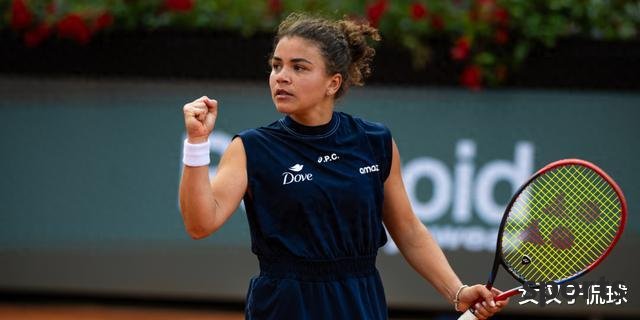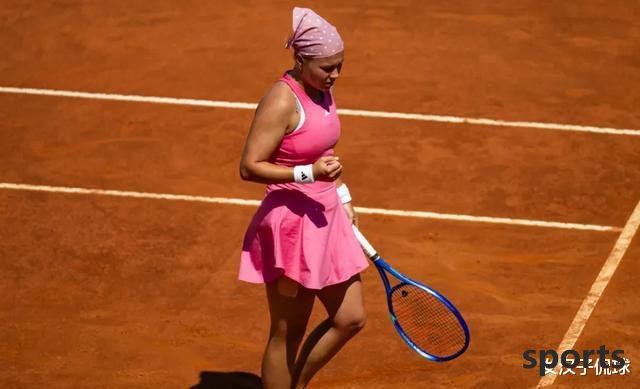2-1 turnaround! The first four-match player in Rome was born, Zheng Qinwen won the best opportunity to compete for the championship
4:23pm, 15 May 2025Football
The magician staged a shocking reversal. The Roman station hidden the Chinese golden flower to the top code
When the night lights on the Rome Olympic Stadium and the Italian local player Paulini scored the winning points in the final set, the entire central stadium burst into cheers like a tsunami. This fierce battle, which took 2 hours and 47 minutes, not only rewritten the promotion map of WTA Rome, but also quietly opened the window for Chinese player Zheng Qinwen to strive for the first WTA 1000 championship in his career.
Schneider from Switzerland showed amazing resilience in the first set. The 42nd player in the world ranked player in a desperate situation of 0-4 lagging behind, dragging the game into a tiebreak with his iconic violent forehand. When the score was frozen at 7-1, the live director's footage captured the solemn expression of the coach Paulini team. This is not a simple technical confrontation, but an ultimate competition between two clay experts on the understanding of the venue.
The turning point occurred at the dramatic turning point of the second trading session. Schneider suddenly fell into a service dilemma after establishing a 4-0 advantage, and the number of double errors climbed to the highest seven times in the game. Paulini seized the moment of his opponent's psychological fluctuation and broke the serve continuously and completed a sweep of 6 games. Technical statistics for the final set show that the Italians increased their receiving and serving score rate to 47%, an increase of 18 percentage points compared with the first set. This ability to adjust on-the-spot is a necessary quality for top clay players.

This victory made Paulini the first local player to enter the semi-finals of Rome in the past five years, and his career clay winning rate rose to 63.8%. It is worth noting that her progress in key points processing: 9 were cashed out at 15 break points in the game, and the second-time scoring rate remained at 51%. These data point to the players' growth trajectory in a high-pressure environment.
For Chinese fans, the real highlight of the event is brewing in the second half of the area. If Zheng Qinwen can continue his magical performance in the Roman Blessed Land, he is very likely to meet Paulini on the final stage. Historical matchmaking records show that China Golden Flower maintains an absolute advantage over the Italians' four-game victory. The latest match occurred at this year's Dubai Station. In the technical statistics of Zheng Qinwen winning in two sets, the pre-net score rate was as high as 72%.
The subtle changes in the competition pattern stem from the physical reserve crisis of many top players. After Sabalenka and Goff met in the finals in Madrid, their performance in their first week of switching to Rome has been exhausted. Data model shows that in the third week of the competition, players who have been playing clay seasons have average movement speeds of 0.3 meters per second, and the forehand error rate has increased by 12%. This periodic fluctuation in the competitive state has created a rare breakthrough window for the new generation of players. The collision of
technical schools is also worthy of fun. Paulini is good at using slip cutting to change the rhythm, and his average hitting rotation reaches 2,800 rpm, which can effectively destroy the opponent's hitting rhythm in clay courts. Zheng Qinwen's offensive system is based on strong bottom line stalemate ability. This season's forehand winning score ranks third in the WTA. This complementary technical style may give birth to a classic showdown. The data team behind the event revealed a deeper trend: 67% of the top four players in the Rome station have received systematic clay training as a teenager. The advantages brought by this early technology setting are often transformed into more accurate placement choices when competing for key points. Paulini's experience of training at the Italian clay training camp since he was 12 years old may explain his tactical execution ability in the final set.
When the event enters the semi-finals, weather factors begin to show influence. The weather forecast shows that the temperature in Rome will rise sharply to 28℃ over the weekend, which puts higher requirements on the players' physical fitness allocation. Historical data shows that the average number of multi-beat rounds in the game in high temperature environments has decreased by 23%, but the winning and error ratio has increased to 1:1.4. This environmental adaptability will become an invisible weight to determine the title.
At the moment when the professional net structure is accelerating iteration, the promotion path of Rome Station is not only related to points and bonuses, but also a touchstone for the new generation to impact the traditional order. When Paulini talked about the semi-final preparation strategy at the post-match press conference, his team revealed that he was focusing on the combination of cutting balls and top-spin balls - this targeted tactical reserve may be laying the groundwork for the upcoming peak showdown.
For Chinese tennis, can this clay season filled with the Mediterranean style really witness a historic breakthrough moment? When technological innovation meets strategic opportunities, this undercurrent championship battle is destined to write a new footnote to the WTA territory.

Related Posts
- Telegraph: Wiltz s parents have disagreements about his next home choice, visited Manchester
- Yukun witnessed the passion for youth football at home
- 1: 2! Conceded 2 goals in 8 minutes, Rice was unable to save his master, Arsenal lost 2 consecutive times, Champions League seat alarm sounded
- The Night of the Fall of Blue Moon: The Epic Battle of Desert Eagles Tearing a Break in European Fortresses
- Sterling s weekly salary is 300,000+ and family is the priority and he is unwilling to go abroad; Chelsea will announce the Champions League list
- Inter Milan vs Como starts: Turam, Lautaro and Barrera substitute, Taremi plays
- The scary Haaland has scored 32 goals in 20 games this season, and only failed to score against Tottenham and Villa.
- Portuguese media: If Yorke Chronicles leaves the team, Portuguese is interested in the Golden Boot of the Spanish Second Division, Suarez will cost 25 million euros
- Ten years of persistence and finally won the championship! 22-year-old Son Heung-min came to Tottenham for 30 million in 15 years, and now he is the captain and won his first championship
